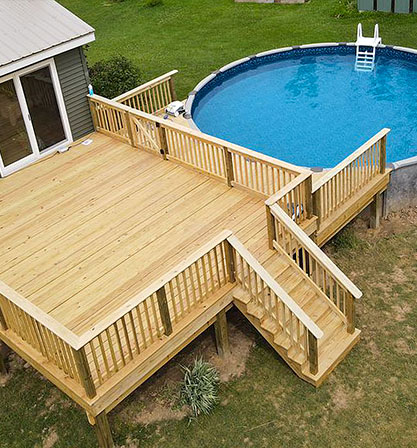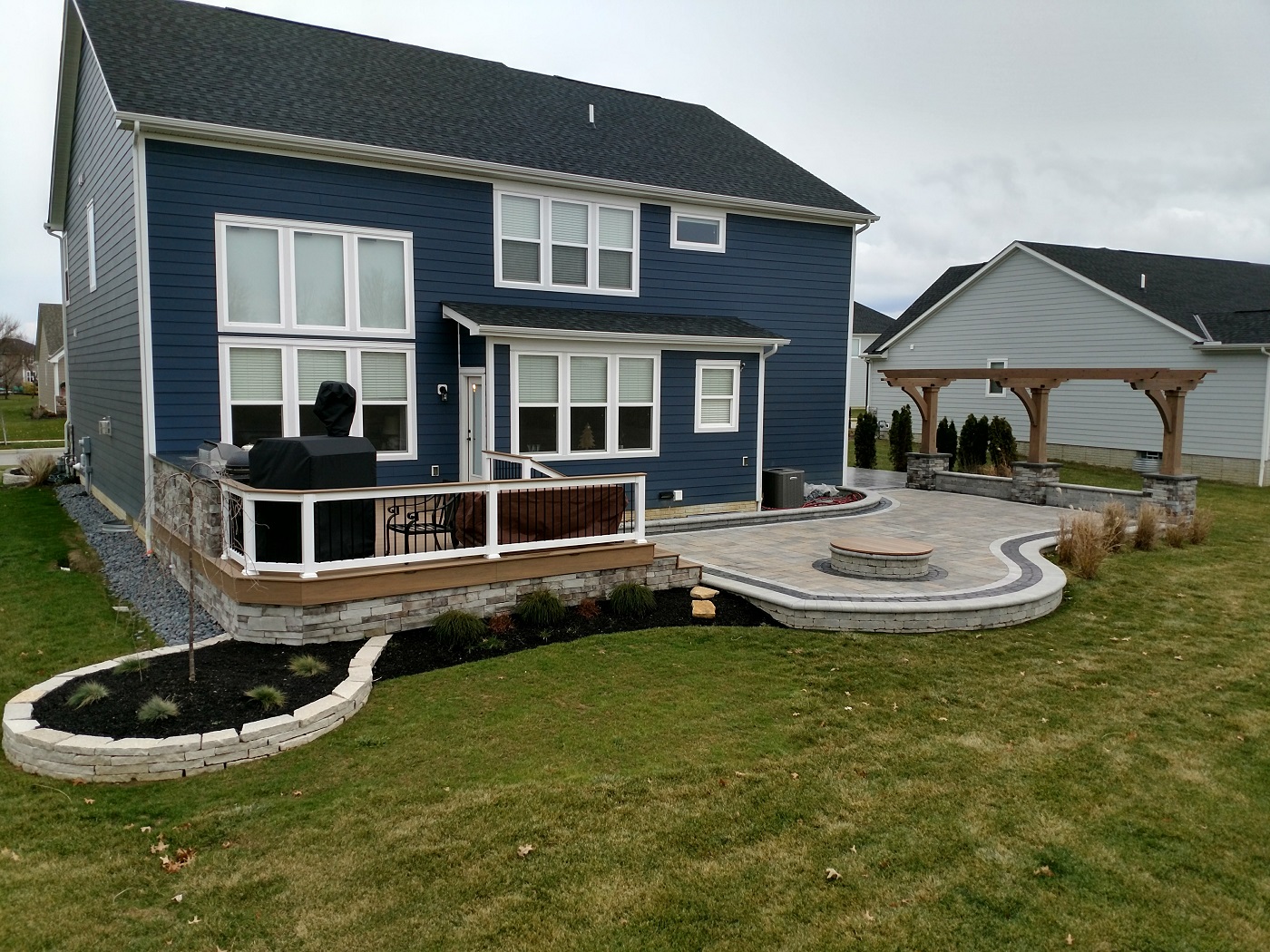Composite deck contractor tips: How to cut, install, and maintain composite decking
Step-by-Step Insights Into the Installation Refine of a Customized Deck
When you're taking into consideration a custom-made deck installment, it's critical to approach the procedure carefully. You'll begin by imagining a layout that suits your way of life and space. Once you have actually got that nailed down, collecting the ideal materials and devices becomes your next emphasis. There's even more to it. The groundwork you lay will establish the stage for an effective build. Let's check out the essential steps that comply with to ensure your deck turns out equally as you thought of.
Preparation Your Deck Layout
When you start intending your deck design, it's important to evaluate both your lifestyle and the area readily available. composite deck contractor. Consider how you mean to make use of the deck. Will it be an area for family celebrations, a quiet resort, or an outdoor eating area? Understanding this helps you identify the size and design.
Following, take a close appearance at your yard. Measure the space and recognize any challenges like trees, inclines, or existing structures that can influence your style. Think of circulation and availability, ensuring you can conveniently relocate between the deck and your home or yard.
Lastly, consider your aesthetic preferences. Do you lean toward a rustic appeal or contemporary beauty? Picking materials and colors that match your design will certainly improve your home's total appeal. By carefully examining these variables, you'll produce a deck that matches your lifestyle while optimizing your outdoor room.
Collecting Necessary Materials and Tools
After completing your deck design, the next action is collecting the required materials and devices. Begin by making a list of all the products you'll require, consisting of outdoor decking boards, joists, screws, and any type of barrier components. Do not neglect regarding completing touches like spots or sealants. It's crucial to choose high-grade materials that match your design and climate conditions.
A framework square and safety and security gear, such as handwear covers and goggles, are also crucial for a secure installment. If you're utilizing composite products, a specialized blade for cutting will certainly make your job less complicated.
Preparing the Site for Installation
Before you start building your custom-made deck, it's vital to prepare the website effectively. Begin by reviewing the area where you prepare to mount the deck.
Following, check the ground's degree. You might require to remove or fill out particular areas to assure a secure structure. If your site has water drainage issues, take into consideration including gravel to advertise appropriate water runoff.
Lastly, mark the boundary of your deck using stakes and string. This will certainly give you a clear aesthetic recommendation for the dimensions and format, making the installation procedure smoother. Taking these preparation steps will set you up for an effective deck setup, making certain whatever's in position for the structure.
Installing the Framework
When you begin setting up the framework for your custom deck, picking the best products is important for resilience and appearances. You'll likewise need to ensure that the structure is set properly to sustain the structure. Let's discuss the very best techniques to make this component of the procedure smooth and reliable.

Picking the Right Materials
Picking the ideal materials for your deck's structure is vital, as it directly impacts the framework's toughness and durability. Start by considering pressure-treated wood for its resistance to rot and pests; it's a prominent choice. If you're looking for something extra resilient, composite products integrate wood fibers and plastic, offering low upkeep and weather condition resistance. Steel or aluminum framework can give toughness and longevity, particularly in rough environments. Don't forget to consider regional environment conditions-- your option should stand up to the elements. Make specific any type of products you pick satisfy regional building codes and requirements. With the appropriate products in place, you'll establish a solid structure for your custom-made deck that lasts for several years.
Setting the Structure Appropriately
To ensure your custom-made deck stands the test of time, setting the structure effectively is crucial. Beginning by marking the deck's layout with risks and string, guaranteeing it's square and degree. Next, dig holes for your footings at least 36 inches deep, listed below the frost line, to avoid moving. Use concrete to safeguard the grounds, enabling it to cure totally. As soon as set, attach article anchors to the grounds, guaranteeing they're plumb and aligned. Install your assistance light beams, making certain they're degree and spaced according to your style. Include joists, complying with neighborhood structure codes for spacing. By taking these actions, you'll develop a strong structure that sustains your deck for years ahead.
Laying Down Decking Boards
Putting down decking boards is an essential action in developing a durable and eye-catching deck. Beginning by picking your boards, confirming they're the appropriate length and material for your design. Lay the very first board at one end of the framework, making certain it's lined up with the side. Use deck screws or concealed bolts to safeguard it in place, keeping it vertical to the joists below.
As you continue, maintain a regular void in between each board to enable water drainage and expansion. Procedure and reduced the boards as required, validating a snug fit at the ends. It's important to look for degree as you go, adjusting the boards if essential. Use a chalk line to lead your positioning, assisting you maintain everything right. As soon as all your boards are down, offer every little thing an once-over to verify it's safe and well-aligned before relocating on to the next steps.
Adding Completing Touches
After safeguarding your outdoor decking boards, it's time to add those finishing touches that enhance both the appearance and functionality of your deck. Beginning by installing barriers for safety and style. Pick a style that matches your home and suits your preference. Next off, think about adding post caps; these not only safeguard your railing blog posts yet additionally include an attractive aspect.
Do not forget illumination! Setting up LED lights along the actions or under the railing can produce a warm and welcoming atmosphere for night gatherings. Ultimately, use a water-repellent sealant to shield your deck from dampness and UV damages, guaranteeing its long life.
You could likewise wish to incorporate planters or attractive elements to personalize your space. With these completing touches, your personalized deck will not just be practical but also a gorgeous expansion of your home, ready for relaxation or amusing. Appreciate your new outside sanctuary!
Keeping Your New Deck
To maintain your brand-new deck looking great, you'll need to remain on top of routine cleansing. Seasonal upkeep is important to shield it from the aspects. Let's explore some simple pointers to help maintain your deck throughout the year.
Normal Cleaning Up Tips
Keeping your brand-new deck in leading shape calls for regular cleansing, and doing so simply a couple of times a year can make a big distinction. Begin by sweeping away leaves and particles to avoid mold and mildew and mildew development. Make use of a gentle soap solution and a soft-bristle brush to scrub the surface area, focusing on any spots or marks. Rinse thoroughly with a pipe to eliminate all soap residue. If you see any kind of mildew, a mixture of vinegar and water can assist tackle it successfully. Prevent using severe chemicals or power washers, as they can damage the timber. Ultimately, examine your deck for any type of indications of wear or damage while cleansing, guaranteeing it remains lovely and practical for several years to find (deck contractors).
Seasonal Upkeep Checklist
As the periods modification, it's vital to remain on top of your deck's upkeep to protect its charm and long life. Start by checking for any indicators of damages, such as splintered boards or loose railings. Tidy your deck completely by brushing up away particles and making use of a mild cleaner to remove discolorations. In the springtime, consider using a fresh layer of sealer to shield against wetness. Throughout the summertime, check for any type of mold and mildew or mold growth, particularly in shady areas. In the autumn, clear fallen leaves and debris to stop rot, and examine for any type of winter months damages. In winter season, think about using a snow blower instead than shoveling to avoid scraping the surface area. Keeping this list in mind will certainly assure your deck remains in top form year-round.

Frequently Asked Concerns
What Allows Are Required for Deck Installment?
You'll generally need a building permit for deck setup, specifically if it's raised. Check your regional guidelines, as needs can more info differ. It's necessary to ensure compliance to stay clear of penalties or having to remove the deck later on.
How much time Does the Installation Refine Commonly Take?
The installation process typically takes one to two weeks, depending on the deck's size and complexity. You'll wish to consider climate condition and any required licenses that could expand the timeline a little.
Can I Build a Deck on Uneven Ground?
Yes, you can develop a deck on uneven ground. You'll need to properly level the foundation, using messages or piers to create a stable surface area. It's crucial to ensure safety and architectural stability throughout the process.
What Kind of Timber Is Best for Toughness?
When it involves durability, you'll wish to consider woods like teak wood or mahogany. Pressure-treated pine likewise provides terrific strength and resistance versus rot. Simply bear in mind to maintain the wood consistently for resilient performance.

Are There Any Type Of Seasonal Factors To Consider for Installment?
When you're planning your installment, think about the season. Springtime and drop offer mild temperature levels, ideal for working with timber. Avoid severe warmth or chilly, as they can influence the materials and your comfort throughout installation.